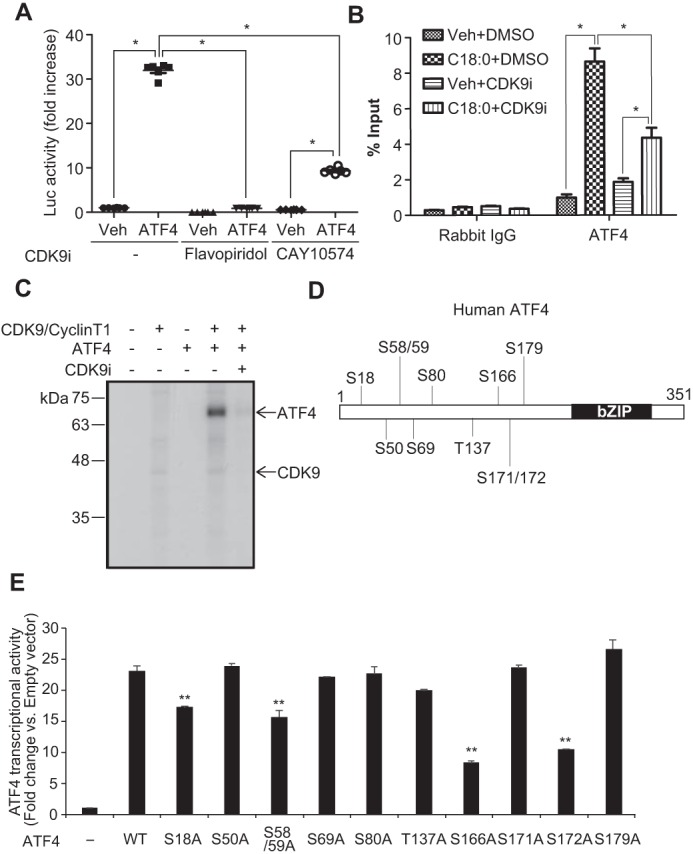Figure 7.

CDK9–cyclin T1 complex regulates the recruitment of ATF4 to the CHOP promoter under ER stress. A, HEK293T cells were co-transfected with firefly luciferase reporter plasmid containing three repeats of the C/EBP–ATF composite (−303/−292) of the mouse CHOP gene, pCMV-LacZ, and control or human ATF4 expression plasmid. 4 h after transfection; cells were incubated in DMEM containing 10% fetal bovine serum with DMSO (Veh) or CDK9 inhibitors (CDK9i) such as 300 nm flavopiridol or 30 μm CAY10574 for 24 h. The results are expressed as luciferase (Luc)/β-gal units of induction (n-fold) over the control value for each construct. One-way ANOVA with a Student-Newman post hoc test was used for comparison between vehicle, flavopiridol, and CAY10574-treated cells (n = 6). B, ChIP analysis of SFA-induced ATF4 recruitment to the C/EBP-ATF composite of the CHOP promoter. VSMCs were pretreated with 10 μm flavopiridol (CDK9i) for 2 h, and then treated with BSA (Veh) or 250 μm C18:0 with or without 10 μm CDK9i. After 6 h, chromatin fractions of VSMCs were prepared. ChIP was performed with rabbit control IgG or ATF4 antibodies. Purified immunoprecipitated DNA was analyzed by qRT-PCR with primers for the C/EBP–ATF composite of the CHOP promoter. The results are expressed as the percentage of antibody binding versus the amount of PCR product obtained using a standardized aliquot of input chromatin (% input) (n = 3). One-way ANOVA with a Student-Newman post hoc test was used for statistical analysis. *, p < 0.05. C, phosphorylation of ATF4 by the CDK9–cyclin T1 complex was analyzed using an in vitro kinase assay. Recombinant human ATF4 and human CDK9–cyclin T1 complex were incubated with or without 100 nm flavopiridol (CDK9i) in a kinase buffer containing [γ-32P]ATP. ATF4 was phosphorylated by both CDK9–cyclin T1 and CDK9–cyclin T2 complexes, and flavopiridol blocked phosphorylation of ATF4. The CDK9–cyclin T1 complex more potently phosphorylated ATF4. Additionally, CDK9 itself was autophosphorylated by the CDK9–cyclin T1 complex. D, human ATF4 phosphorylation site by CDK9. E, luciferase assay using ATF4 with alanine point mutations on each predicted CDK9-specific phosphorylation site. HEK293T cells were co-transfected with firefly luciferase reporter plasmid containing three repeats of the ATF4RE (−303/−292) of the mouse CHOP gene, pCMV-LacZ, and control or human ATF4 WT or serine/threonine mutation expression plasmid (n = 3). One-way ANOVA with a Student-Newman post hoc test were used for statistical analysis. **, p < 0.01 versus ATF4 WT.
